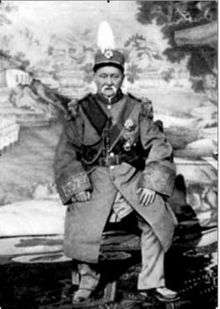Ma Fuxing
| Ma Fuxing 馬福興 | |
|---|---|
 | |
| Tao-yin of Kashgar | |
|
In office 1916–1924 | |
| Succeeded by | Ma Shaowu |
| Personal details | |
| Born |
1864 Yunnan |
| Died |
1924 Kashgar, Xinjiang |
| Nationality | Chinese Muslim |
| Political party | Xinjiang clique |
| Spouse(s) | Harem of Wives |
| Children | Many |
| Religion | Sunni Islam |
| Military service | |
| Allegiance |
|
| Years of service | 1916–1924 |
| Rank | Military commander |
| Unit | Kansu Braves, Kashgar Garrison |
| Commands | Military commander |
| Battles/wars | Boxer Rebellion, Xinhai Revolution in Xinjiang |
| Ma Fuxing | |||||||||||
| Traditional Chinese | 馬福興 | ||||||||||
|---|---|---|---|---|---|---|---|---|---|---|---|
| Simplified Chinese | 马福兴 | ||||||||||
| |||||||||||
Ma Fuxing (Ma Fu-hsing in Wade Giles; 1864–1924) was a Hui born in Yunnan, in Qing dynasty China. He was an ex-convict. During Yang Zengxin's reign in Xinjiang, Ma was appointed as a military commander, and then Titai of Kashgar.[1]
Ma Fuxing served as a general for the Qing dynasty. He joined the Kansu Braves during the Boxer Rebellion, under the command of general Ma Fulu and battled against the foreign forces during the Siege of the International Legations (Boxer Rebellion) and Battle of Peking.[2]
After the fall of the Qing dynasty, he started working for Yang Zengxin and recruited Dungan troops for him in 1911, and was posted in 1916 to Kashgar. In 1924 Yang intercepted some correspondence between Ma and the Zhili clique and became suspicious.[2]
Ma Fuxing was appointed as the commander of 2,000 Hui soldiers by Yang Zengxin.[3]
Reign

His reign was notorious for its repressiveness and his excesses. Ma Fuxing kept a harem of Uighur wives, and a hay cutting machine for severing the limbs of his victims.[4] The limbs were put on display along with notices on why they were severed on the city walls.[5] He also established government monopolies over industries such as petroleum, and made people purchase paraffin wax. Ma Fuxing also demanded that people call him padishah, which meant king.
Downfall
Yang Zengxin decided that Ma's excesses were too great, and sent Ma Shaowu, another Hui military commander, to attack and replace him.[6] Ma Shaowu attacked Ma Fuxing, and then personally executed him by shooting him after receiving a telegram from Yang Zengxin. Ma Fuxing's body was tied to a cross to be put on display.[7] Ma Shaowu then was appointed Daotai of Kashgar.
See also
References
- ↑ Mary Patricia Joan Rouse (1992). Search for a new dominion: revolt and rebellion in Xinjiang, China during the Republican period, 1911-1949. Ithaca: Cornell University. p. 77. Retrieved 2010-06-28.
- 1 2 Garnaut, Anthony. "From Yunnan to Xinjiang:Governor Yang Zengxin and his Dungan Generals" (PDF). Pacific and Asian History, Australian National University). p. 106. Retrieved 2010-07-14.
- ↑ James A. Millward (2007). Eurasian crossroads: a history of Xinjiang. Columbia University Press. p. 168. ISBN 0-231-13924-1. Retrieved 2010-06-28.
- ↑ Christian Tyler (2004). Wild West China: the taming of Xinjiang. New Brunswick, New Jersey: Rutgers University Press. p. 112. ISBN 0-8135-3533-6. Retrieved 2010-06-28.
- ↑ Andrew D. W. Forbes (1986). Warlords and Muslims in Chinese Central Asia: a political history of Republican Sinkiang 1911-1949. Cambridge, England: CUP Archive. p. 24. ISBN 0-521-25514-7. Retrieved 2010-06-28.
- ↑ Andrew D. W. Forbes (1986). Warlords and Muslims in Chinese Central Asia: a political history of Republican Sinkiang 1911-1949. Cambridge, England: CUP Archive. p. 24. ISBN 0-521-25514-7. Retrieved 2010-06-28.
- ↑ Christian Tyler (2004). Wild West China: the taming of Xinjiang. New Brunswick, New Jersey: Rutgers University Press. p. 113. ISBN 9780813535333. Retrieved 2010-06-28.
| Wikiquote has quotations related to: Ma Fuxing |
| Wikimedia Commons has media related to Ma Fuxing. |